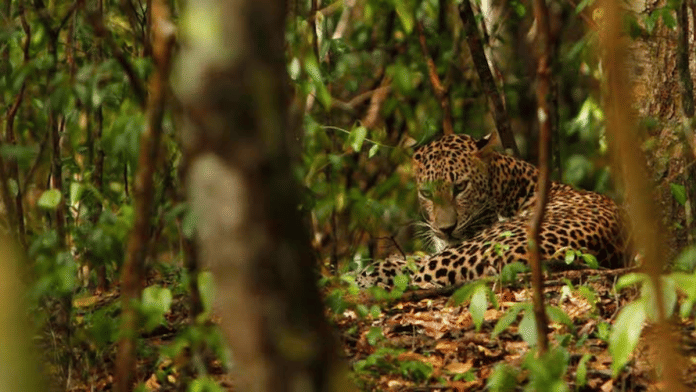Thank you dear subscribers, we are overwhelmed with your response.
Your Turn is a unique section from ThePrint featuring points of view from its subscribers. If you are a subscriber, have a point of view, please send it to us. If not, do subscribe here: https://theprint.in/subscribe/
Recently I got a chance to visit Jhalana – the first leopard reserve of the country. It is a 20 square kilometers of Aravalli scrub forest in the heart of Jaipur- an oasis of nature for the residents of Jawahar nagar, Jagatpura,Malviya nagar and students of educational institutes like Rajasthan University, Government Ramchandra Khaitan Polytechnic College and visitors who have its easy excess because of the highway Agra road next to it.
I was with a group of people from varied backgrounds. Most were of the opinion that scrub forests had no right to exist and only lush green forests were wilderness. This piece is to change that opinion.
Historically
Jhalana was a hunting ground for tigers and leopards- the endangered and near threatened species respectively. As recent as 1922 a tiger and a wild boar were hunted and shot dead by Maharaja Madho Singh II in the forests of Jhalana. Though the last organized shoot was in 1943, poaching continued when it became the leopard reserve in 2017 with a dedicated team to man the forests.
Jhalana also suffered mining. Controlled mining for copper and other metals dates back to at least 5th century BCE. Its plundering took place during the British rule and after independence till 2024 when Supreme Court of India ordered an end to illegal mining in the Aravalli range of Rajasthan.
At present
Jhalana has undulating terrain of ridges, valleys and nalas. Due to very low rain this scrub forest is dominated by Dahu and Khejri trees. Dahu is a large tree with deep roots, thick green leaves, irregularly lobed monkey fruits and feathery canopy. Khejri- the state tree of rajasthan is medium sized selender with deep roots, fir leaves and edible pods. Dahu, Khejri and other flora have adapted to reduce the water loss through transpiration(the process by which plants release some of the water they have absorbed through roots).
Jhalana’s fauna includes 40 leopards, un counted number of blackbuck, deer, desert fox, langurs, rhesus monkeys, nilgai,wild pigs.It also has cobras, vipers, tree and other non-poisonous snakes, as well as Indian palm squirrels, wild hares, mongooses and birds like great Indian Bastards- the state bird of Rajasthan, paradise flycatchers, hawks, shikras, owls, cuckoos, green pigeons, partridges, lapwings,hoopoes, peacocks and migratory birds like Indian pond heron,cranes, egrets, cormorants and bar-headed geese.
Its star species leopards have the power of big cats and agility of smaller cats with muscular fore quarters, slender hind quarters, heavy neck, and long tail each with unique pattern of its spots. Leopards sneak upon their prey, hunt silently, climb the trees, rest in cooler areas and when agitated bare their teeth and roar loudly. Though a leopard can easily kill a human they only attack humans in self defence.
Importance of Jhalana
Its importance is its urban wildlife conservation efforts and make visitors enjoy, like and understand the need for scrub forests in nature.
As i said earlier during my visit to Jhalana my group had either none or wrong information about the reserve. At the Interpretation Center one member was explaining to others,’ look at their head shots look at the size and arrangements of spots, these are different species of leopards in the reserve.
Shri Vijay Pal Singh Dcf Wild Life Zoo Jaipur explained to my team members how spots on leopards were like the fingerprints of humans. Each animal with a specific pattern but all were one species.
Another member stated at another time,’ madam there are so many thorns here, there must be some doctor to remove thorns from leopards feet. He was amazed to learn that thorns don’t bother leopards.
Leopards have strong, thick skin that provides a natural barrier against sharp objects like thorns. Furthermore, their hunting style, often involving stealth and surprise attacks, minimizes their need to navigate through dense, thorny vegetation. While they may encounter thorns during their hunts, particularly when pursuing animals like porcupines that use quills for defense, they are generally resilient to minor injuries.
Videos have shown leopards getting covered in thorns while hunting porcupines, but they are ultimately able to remove the quills and continue their hunt.
Last Words
For all who think scrub forests are useless please know that scrub forests are crucial habitats for a variety of birds, reptiles, amphibians, and mammals. The undergrowth provides hiding places, hunting grounds, and nesting places for smaller animals and birds.
Thorn forests play a crucial role in stabilizing soil, preventing desertification,and supporting biodiversity of semi -arid regions. They should be preserved because they play a crucial role in maintaining the health of ecosystems, regulate climate, prevent soil erosion, and used for ecotourism, benefiting local communities.
Visit Jhalana, see the beauty of a scrub forest and learn its worth and importance.
These pieces are being published as they have been received – they have not been edited/fact-checked by ThePrint.


